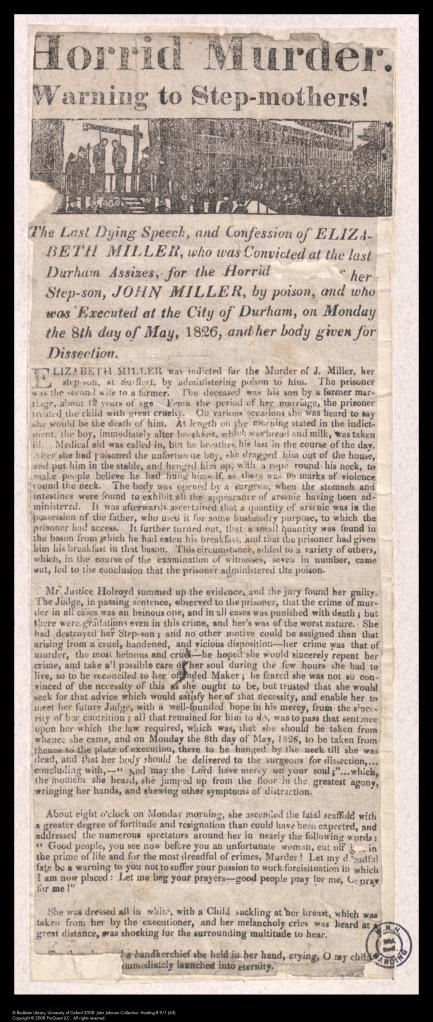
There are many undoubtedly shocking details in this report of a truly ‘horrid-murder,’ but perhaps the most shocking of all is that it never happened.
To be more precise, it did happen, but not in Durham, was not committed by Elizabeth Miller and was not inflicted on John Miller.
I came across this broadside (traditionally a single sheet that carried public notices, news, speeches and songs or in the case of my study – execution reports) while searching the Bodleian library’s collection of ephemera. It threw me, because after the best part of a month cataloging every execution in my period and any press reports of the events I can find, I couldn’t believe there was one I had missed. I spent about 5 minutes in a cold sweat thinking about how many more I could’ve missed and started to doubt my ability to do GCSE level history research, let alone PhD (luckily my neuroses soon subsided).
In a bid to prove I could do decent independent research I went on a three hour diversion to track down how this could’ve arisen and what I found was really interesting.
On Saturday the 27th October, 1821, 5 years prior to the printing of this broadside, a woman was hung in the City of Lincoln for the murder of her stepson. Her name was Elizabeth Warriner and her step son was a Mr J. Warriner. Shortly after there was a broadside printed of her Last Dying Words, Speech and Confession (a document that bares a remarkable likeness to that of Elizabeth Millers).

What is so remarkable is how little of the details were changed. Even the sentencing Judge’s name remains the same in the two reports, which shows how little effort went in to creating this new version. There are many interesting questions that arise from this copy. The most important for myself being how reliable are these sources.
The broadsides themselves were undoubtedly a cheap, affordable medium targeted at a much wider public than traditional print media. They could be turned round very quickly and disseminated for a good profit, often running to many sheets per murder (covering anything from the trial itself to the last dying words of the executed person). What is most interesting about Elizabeth Warriner’s Last Dying Words, is that the copy that has survived was printed in Glasgow, despite the execution being in Lincoln. This goes a little way to indicating how voracious the appetite often was for criminal and salacious literature of this type. The audience for it spread far and wide.
Michel Foucault in his seminal study of punishment and the birth of the prison, takes the proliferation of reported and printed ‘gallows speeches’ with a hefty pinch of salt. While he accepts that ‘in a number of cases, certainly’ the speeches were delivered as reported, he states that he has ‘no doubt’ that it was ‘more often the case’ that they were a fiction.¹ From my early research I have been using newspaper reports to cross reference the last dying speeches I have found and for the most part they tend to corroborate each other, while providing a different style and tone of reporting, but this incident has been a very good lesson in one of the basic tenets of good historical study – interrogate your sources.
So, having felt like a good bit of research has been done, I should smugly sign off this post, but when I re looked at the original Bodleian source, I searched further down the page and saw they had provided a connecting link to Elizabeth Warriner’s broadside already. Oh well, for a brief moment I was a good researcher. At least I have 35 months left to improve.
1). Foucault, Michel., Discipline and Punish, Vintage Books 1977, p.67
Special Thanks: In my first month, I have met with several fascinating people already. This week I had the pleasure of going to Sunderland Antiquarian Society after I stumbled upon an article about them, linking to an execution I was investigating. Set in a beautiful old building on Douro Terrace, just behind the fantastic Mowbray Park, the two hours I spent there was immensely useful. All the volunteers and attendees were fantastic. and immensely friendly and willing to help with my inquiry and quick to offer other suggested avenues of interest. Special thanks must go to Norman Kirtlan, Phil Curtis, Doug Smith and Ms L.King (I will sign up I promise).
Distraction 1: I heard a tune, chosen by Biddy Baxter (of former Blue Peter fame) on Desert Island Discs and I couldn’t place where I knew it from. The tune was Quasi Lento e Cantabile from Carol Symphony performed by the Pro Arte Orchestra. It suddenly clicked where I knew it from and it sent me off on a trip down memory lane. A variation of it was used as the opening title music for the classic Box of Delights series on BBC. An amazing series that, in a nice coincidence, started the year I was born. Here’s the opening music for anyone who was similarly spellbound by the series. I’m off to go flying with Cole Hawlings.
Distraction 2: There is a fantastic documentary about musician Bill Withers on the BBC iplayer. A really remarkable character and a very simply and brilliantly executed piece of storytelling. If it interests you, there is a related Bill Withers in concert piece on BBC Four which is well worth a watch too.

Pingback: Supervisors, Secret Executions and Ziggurats | lastdyingwords